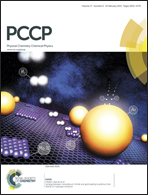Evaluation of electrostatic binding of PAMAM dendrimers and charged phthalocyanines by fluorescence correlation spectroscopy†
Abstract
We have assessed host–guest interactions between PAMAM dendrimers and charged phthalocyanine probes by Fluorescence Correlation Spectroscopy (FCS). Our results show strong binding in water at low ionic strength with an affinity that decreases from KB ∼ 109 to 108 M−1 upon decreasing the phthalocyanine charge of z = −4, −2 and −1. The binding affinity also decreases significantly upon salt addition leading to KB values of ca. 105–106 M−1. The changes of binding affinity probed by varying the phthalocyanine charge, and by changing the ionic strength or pH conditions, allowed us to evaluate the electrostatic contribution (Kel) in dendrimer–phthalocyanine interactions. In particular, this approach afforded values of electrostatic potential for PAMAM dendrimers in water at low ionic strength and at dendrimer concentrations in the nanomolar range. The electrostatic potential of PAMAM generations 4 and 7 are around 50 mV in close agreement with theoretical estimates using the Poisson–Boltzmann cell model. Interestingly, the nonelectrostatic binding is significant and contributes even more than electrostatic binding to dendrimer–phthalocyanine interactions. The nonelectrostatic binding contributes to an affinity of KB above 105 M−1, as measured under conditions of low dendrimer charge and high ionic strength, which makes these dendrimers promising hosts as drug carriers.



 Please wait while we load your content...
Please wait while we load your content...